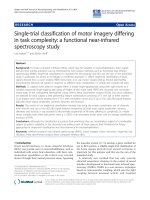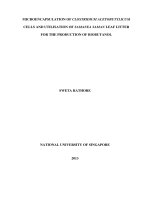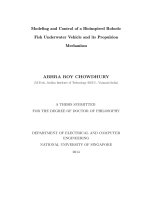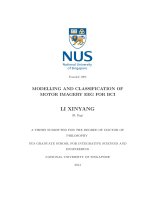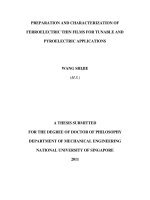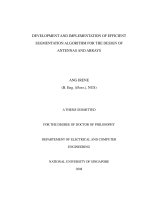Modelling and classification of motor imagery EEG for BCI
Bạn đang xem bản rút gọn của tài liệu. Xem và tải ngay bản đầy đủ của tài liệu tại đây (1.21 MB, 186 trang )
Founded 1905
MODELLING AND CLASSIFICATION OF
MOTOR IMAGERY EEG FOR BCI
LI XINYANG
(B. Eng)
A THESIS SUBMITTED FOR THE DEGREE OF DOCTOR OF
PHILOSOPHY
NUS GRADUATE SCHOOL FOR INTEGRATIVE SCIENCES AND
ENGINEERING
NATIONAL UNIVERSITY OF SINGAPORE
2014Acknowledgments
ii
Acknowledgments
I would like to express my deep and sincere gratitude to my supervisor,
Associate Professor Ong Sim Heng. He trusted me and provided me a great
opportunity to be under his supervision when I was faced with difficulties.
This was invaluable and meant a lot to me. Prof. Ong was very responsible,
patient and considerate. He even revised my manuscripts on the weekends,
when I did not finish them early enough before the deadline. Moreover, he
helped me a lot when I failed to take everything into consideration. The most
important thing I learnt from him was how to be responsible and professional
in research, which will definitely benefit me in my future work.
I would like to express my deepest gratitude to Dr. Guan Cuntai. With-
out Dr. Guan’s help, guidance and understanding, I would never have fin-
ished my Ph.D. work and achieved what I have achieved. Although he is
very busy, he spent a lot of time with students like me to give us guidance
and help on our research. He taught me to think wide and to have a higher
and clearer goal for research, while in practical works he guided me to make
progress step by step. It is really fortunate for me to work in his team. It is a
great and invaluable experience for me to meet and learn from top scientists
and researchers in BCI, brain science and neuroscience.
My sincere gratitude goes to the NUS Graduate School for Integrative Sci-
ences and Engineering (NGS) for providing me with a great opportunity and
financial support to pursue my Ph.D. degree. I specially would like to thank
Associate Professor Tang Bor Luen, Professor Ding Jeak Ling and Professor
Philip Moore, who gave me great help and support when I was encountered
iii
Acknowledgments
with difficulties. Their encouragement and trust are really meaningful to me.
I would like to express my gratitude to Professor Li Xiaoping, who is my
thesis advisory committee chair. He has provided me invaluable advices and
assistance in my research study.
My sincere gratitude and respect go to Dr. Ang Kai Keng and Dr. Zhang
Haihong, who gave me a lot of guidance for my research, and helped me
improve my scientific writing skill. I would like to express my gratitude to
Dr. Pan Yaozhang for her help and guidance when I just started my Ph.D.
knowing nothing about BCI.
I want to say that before I started my Ph.D., I was really curious about
the attributes of a scientist. All these people taught me not only what a
good and professional scientist should be but more importantly how to be a
good and professional scientist.
I also want to thank Ms. Irene Christina Chuan and Ms. Ivy Wee for
their help and patience on handling tedious paper work for me.
My sincere gratitude and respect go to all members in the Brain Computer
Interface Lab for making this lab such a wonderful place to do research. And
my thanks goes to my colleagues, Ms Atieh Bamdadian, Dr. Sidath Ravindra
Liyanage, Dr. Mahanaz Arvaneh, Mr. Siavash Sakhavi and Ms Foong Ruyi.
I really enjoyed discussing and talking with all of them, although I might not
appear to be that way.
I would like to express my gratitude to Singapore, and all the adorable
animals (owls, squirrels, pangolins and monkeys, etc.), trees and flowers here,
which make me feel that the world is really wonderful.
At last but not least, I give my dearest gratitude to my family, especially
my mom, who always believes I am better than what I think of myself, and
iv
probably better than whom I actually am.
v
Acknowledgments
vi
Contents
1 Introduction 1
1.1 Background . . . . . . . . . . . . . . . . . . . . . . . . . . . . 1
1.1.1 Brain Computer Interface . . . . . . . . . . . . . . . . 1
1.1.2 Processing Procedures in a BCI system . . . . . . . . . 5
1.2 Objectives . . . . . . . . . . . . . . . . . . . . . . . . . . . . . 8
1.3 Structure of the Thesis . . . . . . . . . . . . . . . . . . . . . . 11
2 Literature Review 15
2.1 Common Spatial Pattern Analysis . . . . . . . . . . . . . . . . 15
2.2 Theoretical Analysis of CSP . . . . . . . . . . . . . . . . . . . 18
2.3 Joint Optimization of Spatial Temporal and Spectral Parameters 19
2.4 Extensions of CSP for Nonstationarity . . . . . . . . . . . . . 22
2.5 Conclusion . . . . . . . . . . . . . . . . . . . . . . . . . . . . . 26
3 Discriminative Learning of Propagation and Spatial Pattern
29
3.1 Data Model and Problem Formulation . . . . . . . . . . . . . 31
3.2 Joint Estimation of Propagation and Spatial Pattern . . . . . 34
3.3 Background Noise Separation . . . . . . . . . . . . . . . . . . 37
3.4 Experimental Study . . . . . . . . . . . . . . . . . . . . . . . . 42
3.4.1 Experiment Set-Up and Data Description . . . . . . . . 42
3.4.2 Data Processing . . . . . . . . . . . . . . . . . . . . . . 42
3.4.3 Investigation on the Order of the Time-Lagged Demix-
ing Matrix . . . . . . . . . . . . . . . . . . . . . . . . . 43
vii
Table of Contents
3.4.4 Classification Results . . . . . . . . . . . . . . . . . . . 44
3.4.5 Analysis of Background Noise Separation . . . . . . . . 46
3.4.6 Discussion . . . . . . . . . . . . . . . . . . . . . . . . . 52
3.5 Conclusion . . . . . . . . . . . . . . . . . . . . . . . . . . . . . 54
4 Ensemble Learning of Spatial Filter Design 57
4.1 Spatial Filter Design Based on Ensemble Learning . . . . . . . 58
4.1.1 Problem Formulation . . . . . . . . . . . . . . . . . . . 58
4.1.2 Spatial Filter Design . . . . . . . . . . . . . . . . . . . 60
4.1.2.1 Selection of Exceptional Samples . . . . . . . 61
4.1.2.2 Ensemble Learning of Spatial Filters . . . . . 62
4.2 Experimental Study . . . . . . . . . . . . . . . . . . . . . . . . 64
4.2.1 Experiment Set-Up and Data Description . . . . . . . . 64
4.2.2 Data Processing . . . . . . . . . . . . . . . . . . . . . . 65
4.2.3 Classification Results . . . . . . . . . . . . . . . . . . . 65
4.2.4 Spatial Filter Comparison . . . . . . . . . . . . . . . . 70
4.2.5 Discussion . . . . . . . . . . . . . . . . . . . . . . . . . 72
4.3 Conclusion . . . . . . . . . . . . . . . . . . . . . . . . . . . . . 74
5 Model Adaptation Based on Tensor Decomposition 75
5.1 Spatial Filter Adaptation Based on Tensor Decomposition . . 76
5.1.1 Spatial Filtering in Tensor Decomposition Form . . . . 76
5.1.2 Tensor Decomposition Based Adaptation . . . . . . . 79
5.1.2.1 Residual Error Estimation . . . . . . . . . . . 80
5.1.2.2 Regularization of the Error Term . . . . . . . 82
5.2 Experimental Study . . . . . . . . . . . . . . . . . . . . . . . 84
5.2.1 Experiment Set-Up and Data Description . . . . . . . . 84
viii
Table of Contents
5.2.2 Data Processing and Feature Extraction . . . . . . . . 84
5.2.3 Analysis of Residual Error . . . . . . . . . . . . . . . . 86
5.2.4 Classification Results . . . . . . . . . . . . . . . . . . . 88
5.2.5 Discussion . . . . . . . . . . . . . . . . . . . . . . . . . 97
5.3 Conclusion . . . . . . . . . . . . . . . . . . . . . . . . . . . . . 100
6 Model Adaptation through Subspace Tracking 101
6.1 Problem Formulation . . . . . . . . . . . . . . . . . . . . . . . 102
6.1.1 Spatial Filter Adaptation Based on Normalization . . . 102
6.1.2 From Discriminative Subspace to Feature Space . . . . 104
6.2 Spatial Filter Adaptation through Subspace Tracking . . . . . 107
6.2.1 Preliminary of Divergence-Based CSP . . . . . . . . . . 107
6.2.2 Subspace Tracking . . . . . . . . . . . . . . . . . . . . 108
6.2.3 Semi-Supervised Gradient Descent Searching . . . . . . 110
6.3 Experimental Study . . . . . . . . . . . . . . . . . . . . . . . . 111
6.3.1 Experiment Set-Up and Data Description . . . . . . . . 111
6.3.2 Data Processing and Feature Extraction . . . . . . . . 111
6.3.3 Numerical Study . . . . . . . . . . . . . . . . . . . . . 113
6.3.4 Classification Results . . . . . . . . . . . . . . . . . . . 120
6.4 Conclusion . . . . . . . . . . . . . . . . . . . . . . . . . . . . . 125
7 Conclusion and Future Work 127
7.1 Conclusion . . . . . . . . . . . . . . . . . . . . . . . . . . . . . 127
7.2 Limitations and Future Work . . . . . . . . . . . . . . . . . . 130
Bibliography 151
ix
Table of Contents
A Appendix 153
A.1 Experiment Set-Up . . . . . . . . . . . . . . . . . . . . . . . . 153
A.2 Relations Between the Convolutive Model and the Instanta-
neous Model with Connected Sources . . . . . . . . . . . . . . 155
A.3 Tensor-Related Notations and Basic Definitions . . . . . . . . 157
A.4 Derivation of the Update Equations in Algorithm 3 . . . . . . 159
A.5 Comparison of Different “Flipping” Methods . . . . . . . . . . 160
A.6 Rotation Matrix in 3D-Space . . . . . . . . . . . . . . . . . . 163
x
Summary
This thesis describes the construction of discriminative models for motor
imagery EEG classification in brain computer interfaces (BCIs). Two types
of methods are introduced to address the issues from the perspectives of
model generalization and model adaptation.
The computational model for motor imagery EEG feature extraction
needs to be a discriminative function conforming to the underlying dynamics
of motor imagery, and robust against nonstationarity inherent in EEG. There
exist successful methods that extract the event-related (de)synchronization
(ERD/ERS) effects by designing spatial filters that maximize differences be-
tween EEG signals from different classes. However, in the presence of causal
relationships and neuronal propagation, spatial filters in the instantaneous
mixing model are not capable of describing such dynamics. To this end, a
novel computational model for discriminative learning of propagation and
spatial pattern is proposed. By introducing a convolutive model, the causal
relationship could be covered in extracting ERD/ERS related features. Ex-
perimental studies on a two-class motor imagery data validate the effec-
tiveness of the model, and indicate that the proposed model is better for
background-noise attenuation. An ensemble learning method is proposed to
improve the feature extraction model by addressing the biased estimates of
covariance matrix. The mismatch between the data and the feature extrac-
tion model are used to re-sample the training trials, and different models
are generated for different sub-sets of trials. The spatial filters are obtained
by ensembling multiple models, and discrepancies between samples can be
xi
Summary
addressed. The experimental results demonstrate that the ensemble learning
model can improve the classification accuracy.
The large variation in EEG signals recorded on different days makes learn-
ing such nonstationarity within training data ineffective. It is necessary for
the computational model constructed from the training data to adapt to the
test data. The key challenge involved in computational model adaptation is
how to construct a metric that measures this mismatch between test data
and training model without test labels. To solve this problem, we construct a
data-model mismatch metric to evaluate the feature extraction model, which
is used to guide the adaptation toward reducing data-model mismatch in
the proposed model adaption method. Experimental results show that the
quantified mismatch is closely related to the classification accuracy, and com-
parison with other state-of-the-art spatial filter design methods validates the
proposed model adaption method. To further understand the nonstationarity
inherent in EEG and its implication on feature distribution change, a theo-
retical analysis is performed from the perspective of discriminative subspace
of the EEG covariance matrix. By establishing the relationship between
the shift of the discriminative subspace and that in feature space, a model
adaptation method is proposed with the discriminative subspace updated
for the test data. To take the risk from semi-supervised learning into con-
sideration, a cross-validation-based loss function is proposed to evaluate the
adaption direction. Experimental results show that compared to the adap-
tation method based on normalization, the proposed adaptation method can
further enhance the classification results.
xii
List of Tables
3.1 Session-to-session transfer test results (%) . . . . . . . . . . . 47
3.2 KL-divergence comparison(%) . . . . . . . . . . . . . . . . . . 49
4.1 Competition III Dataset IVa test results (140-140) (%) . . . . 68
4.2 Test results (16-subject dataset) (%) . . . . . . . . . . . . . . 68
4.3 T-test results for different groups of subjects. . . . . . . . . . . 68
5.1 Session-to-session transfer classification results on the evalua-
tion batch (%). . . . . . . . . . . . . . . . . . . . . . . . . . . 90
xiii
List of Tables
xiv
List of Figures
1.1 An example of motor-imagery-based BCI rehabilitation system 5
1.2 EEG processing procedures involved in BCI . . . . . . . . . . 9
1.3 Thesis structure . . . . . . . . . . . . . . . . . . . . . . . . . . 13
3.1 Norms of coefficient matrices under MVAR model. The x-axis
represents the order τ and y-axis represents the norm of B(τ).
Three MVAR models with orders q from 4 to 6 are used to
fit EEG data of training and test sets separately, yielding six
lines. And the peak points of the six lines correspond to either
τ = 2 or τ = 3. . . . . . . . . . . . . . . . . . . . . . . . . . . 45
3.2 Test classification accuracy comparison. The x-axis represents
the accuracy result under CSP and the y-axis represents that
under DPSP with different orders p. The y = x line is denoted
in dotted-dashed line. In each plot, a circle above the y = x
line marks a subject for which DPSP outperforms CSP. It can
be seen from the plots that improvements of DPSP for order
2 and 3 are significant. . . . . . . . . . . . . . . . . . . . . . . 48
3.3 Decrease in the KL-divergence. The decreases in the KL-
divergence in
X of different orders compared to X are shown
in percentage. Great decrease in the KL-divergence indicates
that
X is more stationary than X. Therefore, the proposed
DPSP algorithm can reduce varying background noise and
session-to-session transfer effects. . . . . . . . . . . . . . . . . 50
xv
List of Figures
3.4 Correlation between the decrease of the KL-divergence and the
increase of the classification accuracy. The x-axis represents
the decrease of the KL-divergence and y-axis represents the
increase of the classification accuracy. Subfigures (a) and (b)
correspond to p = 2 and p = 3, respectively. . . . . . . . . . . 51
3.5 Comparison of coefficient matrices obtained by the proposed
method, A(τ), and the mixing matrices in MVAR, B(τ). For
both subjects, the diagonal elements of B(τ ) are much higher
than the off-diagonal elements. For A(τ), elements of higher
values are found in certain columns. . . . . . . . . . . . . . . . 53
4.1 An example of a 2D feature distribution obtained by CSP. The
line x = y is denoted in dashed line, which can be regarded as
a classifier. Red and blue crosses represent features lying on
the wrong side. . . . . . . . . . . . . . . . . . . . . . . . . . . 59
4.2 Flow chart of the proposed method. Subsets of training data
consisting of exceptional trials are formed, different spatial
filters are generated based on different subsets of trials, and
finally the feature extraction model, W
e
, is obtained by com-
bining these models. . . . . . . . . . . . . . . . . . . . . . . . 60
4.3 Test classification accuracy comparison. The x-axis represents
the accuracies under CSP, and the y-axis represents the accu-
racies under the proposed method. Generally, there are more
dots above the line y = x. Moreover, on the left side of the
figure there are more subjects with improvements by using the
proposed method, who are the subjects with BCI illiteracy. . . 69
xvi
List of Figures
4.4 An example of feature distribution comparison (subject av).
The 2D features correspond to the first and the last spatial
fitters in W or W
e
. The overlap of features from the two classes
is reduced by using the proposed method for both training set
and test set. . . . . . . . . . . . . . . . . . . . . . . . . . . . . 70
4.5 An example of spatial filter weights in projection matrices W
and W
e
(subject 2). In W
e
, the weights of the spatial filter
maximizing the right hand motor imagery are more concen-
trated on the left hemisphere compared with that in W. . . . 71
5.1 Relation between the residual error and classification accu-
racy. Each circle or triangle marks one subject. The x-axis
represents the classification accuracy and the y-axis represents
||E
tr
|| or ||E
te
||. For both training data and test data, there is
a trend that a larger ||E
tr
|| or ||E
te
|| may correspond to a lower
classification accuracy. Pearson’s correlation test shows a sig-
nificant correlation for training data with coefficient r
c
equal
to −0.60 and p-value equal to 0.01. . . . . . . . . . . . . . . . 87
5.2 The change in ||
ˆ
E
te
|| with respect to the iteration number k.
As shown in this figure, the change in ||
ˆ
E
te
|| becomes very small
after 2 iterations. Thus, for the efficiency of computation, it
is reasonable to run the iterations twice. . . . . . . . . . . . . 88
xvii
List of Figures
5.3 Tracking the nonstationary feature space across sessions. Com-
paring the feature distributions extracted from the training
session and two test batches, we observe that the feature dis-
tributions become more consistent across sessions by employ-
ing TDA, with the distances between training features and
test features significantly reduced. . . . . . . . . . . . . . . . . 92
5.4 Visualization of class-wise feature distributions. The non-
linear classification boundary in NBPW classifier is presented
by the contrast of different color patterns. By employing TDA,
more features fall in the corresponding side of the boundary. . 93
5.5 Change of ||E|| with respect to µ. The x-axis represents the
value of µ, and the y-axis represents ||E
tr/te
|| averaged across
subjects. ||E
tr/te
|| based on FBCSP without any adaptation
are denoted with dotted-dashed lines. . . . . . . . . . . . . . . 94
5.6 Change of accuracy with respect to µ. The x-axis represents
the value of µ, and the y-axis represents accuracy averaged
across subjects. . . . . . . . . . . . . . . . . . . . . . . . . . . 95
5.7 Change of accuracy with respect to change of ||E||. The x-
axis represents the decrease of ||E||, and the y-axis represents
change of accuracy. Each triangle marks one subject. . . . . . 96
6.1 An example of 2D feature distribution using channels C3, C4
and Cz, where the features from class + and class - are pre-
sented by triangles and circles, respectively. And the mean of
each class is presented by a solid triangle/circle. . . . . . . . . 114
xviii
List of Figures
6.2 The subspaces u
1
, u
2
, and u
3
in U . An example of rotating U
around u
2
with θ = 0,
π
30
,
π
15
, ,
π
6
is given by the intermediate
colors from blue/red to yellow/pink. . . . . . . . . . . . . . . . 115
6.3 Change of the distributions of f
j
(θ, u
1
) with θ. The discrimina-
tion of the feature dimension f
1
is not affected by the rotation.
The ideal classifier becomes a vertical line when θ =
π
2
. . . . . 117
6.4 Change of the distributions of f
j
(θ, u
2
) with θ. Both feature
dimensions are affected by the rotation. It is impossible to
achieve the same classification accuracy by changing the clas-
sifier only. . . . . . . . . . . . . . . . . . . . . . . . . . . . . . 118
6.5 Change of the distributions of f
j
(θ, u
3
) with θ. The discrimina-
tion of the feature dimension f
3
is not affected by the rotation.
The ideal classifier becomes a horizontal line when θ =
π
2
. . . . 119
6.6 Accuracy comparison. The average accuracy of the proposed
method using W
te
is 67.42%, which is higher than that of using
W
n
, i.e., 66.41%. . . . . . . . . . . . . . . . . . . . . . . . . . 121
6.7 Change in L
b
with respect to iteration number k. . . . . . . . 122
6.8 Change in L with respect to iteration number k. . . . . . . . . 122
6.9 Change in classification accuracy with respect to the iteration
number k. The x-axis represents the value of k, and the y-axis
represents classification accuracy. Acc
a
and Acc
e
represent
the classification accuracies of adaptation batch and evalua-
tion batch, respectively, and the baselines of the normalization
approach are denoted by dotted-dashed lines. . . . . . . . . . 123
A.1 Scalp map of the 27 channels. . . . . . . . . . . . . . . . . . . 153
xix
List of Figures
A.2 Time segmentation of one trial. . . . . . . . . . . . . . . . . . 154
xx
Chapter 1
Introduction
1.1 Background
1.1.1 Brain Computer Interface
The discovery that electrical signals produced by the human brain could be
recorded from the scalp implies the possibility of communicating with exter-
nal devices via brain independent of muscle, and subsequently, makes brain
computer interface (BCI) research a burgeoning field [1, 2]. By measuring
central nervous system (CNS) activity, a BCI system enables people to access
and understand the ongoing brain activities, and also provides alternative
brain output pathways that are independent of normal brain outputs such as
peripheral nerves. Applications of BCI range from modulating normal CNS
output to facilitating new interactions between CNS and the environment
[3].
There exist many kinds of brain signals, which can be categorized by the
type of measurement technique being used or the nature of the brain activity
being measured. For instance, activation, communication and information
transfer in the CNS are fulfilled by neuronal action potentials (or spikes),
which also give rise to neuronal electrical activities in the cerebral cortical
surface [4]. Such electric fields are accessible to magnetic recording, such as
1
Chapter 1. Introduction
magnetoencephalography (MEG), and various types of electric recordings at
different spatial scales, including electroencaphalography (EEG), electrocor-
ticography (ECoG), and multielectrode arrays implanted in the brain tissue
[5, 6, 7, 8]. Besides electric signals, chemical processes involved in brain
activities can also be measured, e.g., using positron emission tomography
(PET) [9, 10]. In addition, the metabolic process involved in the energy con-
sumption during different brain activities can be revealed by the change in
hemoglobin, which is regarded as the blood-oxygen-level-dependent (BOLD)
response [11, 12]. Based on the BOLD response, there are metabolic signal
measurements including functional near-infrared spectroscopy (fNIRS) and
functional magnetic resonance imaging (fMRI) [13, 14, 15, 16, 17, 18].
Among all the aforementioned different measurement techniques, EEG is
the most popular and widely-used measurement in BCI systems [19]. Com-
pared to EEG, both fMRI and MEG are more expensive and call for much
more complicated implementation. Also, PET, fNIRs, and fMRI suffer from
poor temporal resolution and delayed responses, which make these measure-
ments less feasible for most of the BCI applications in reality. In contrast,
electrical signals usually have relatively high temporal resolution and fast
response. However, electric signal measurements except EEG, i.e., ECoG
and implanted electrodes, are also less practical and convenient, because as
invasive methods these measurements need surgical operations. In conclu-
sion, EEG-based BCI is the most widely studied and applied BCI paradigm,
which can be attributed to the following advantages of EEG:
i) EEG provides real-time measurements for on-going brain activities;
ii) EEG can be implemented under relatively lower cost; and
2
1.1. Background
iii) EEG recording is non-invasive.
EEG-based BCI systems vary depending on the EEG signals used to
drive the system, which can be categorized by the type of the signal genera-
tion. One kind of the EEG signals is generated by external stimulus, and is
regarded as evoked potentials (EPs). For example, P300 is a kind of endoge-
nous event-related brain potentials (ERPs) in EEG, and it occurs over the
central-parietal scalp around 300 milliseconds after a rare stimulus appears
in the typical “odd-ball” experiment paradigm [20, 21, 22]. The speller based
on P300 with the “odd-ball” paradigm is one of its most important applica-
tions, and it functions in a similar way to a standard computer keyboard.
In the experiment, a subject is presented with a matrix of characters, and
required to attend to one of the elements in it. By successively and randomly
intensifying either a row or a column of the matrix, the “odd-ball” event is
created when the intensification event is relevant to the element with the
subject’s attention. Thus, P300 can be triggered and observed from EEG
when such events occur [23, 24]. By eliciting and detecting P300, a “virtual
keyboard” BCI system is created as a helpful alternative communication or
control approach for the disabled people who cannot use normal control de-
vices [25, 26, 27, 28].
In contrast to the signals that are generated as the direct results of exter-
nal stimulus, another kind of commonly used EEG signals are spontaneous
changes in rhythmic activity recorded over the sensorimotor cortex known
as sensorimotor rhythms (SMRs) [29, 30]. Changes in the SMRs are typi-
cally associated with motor cortex activation [31]. In particular, decrease in
SMRs, known as ERD, has been discovered during motor behaviors, followed
3
